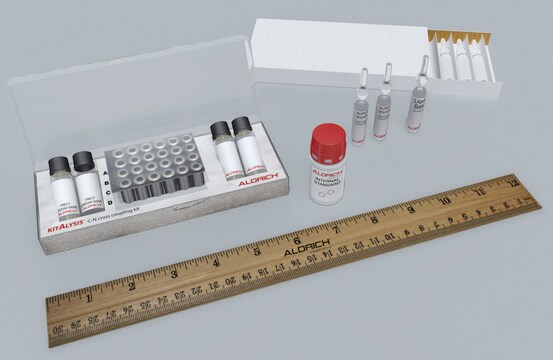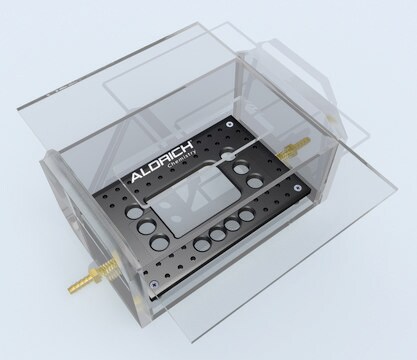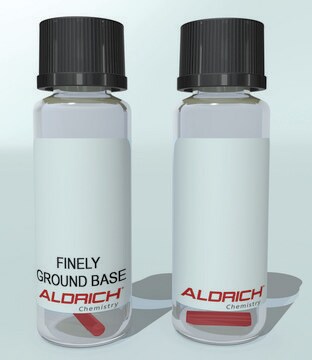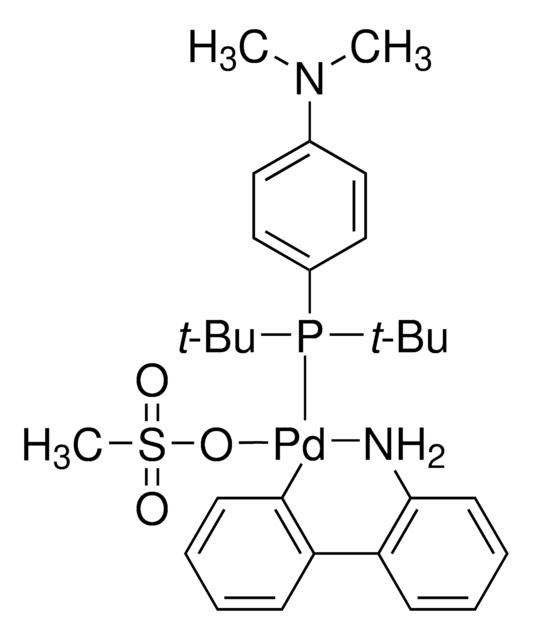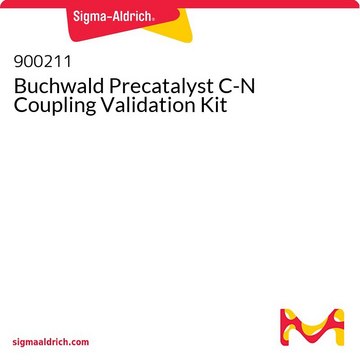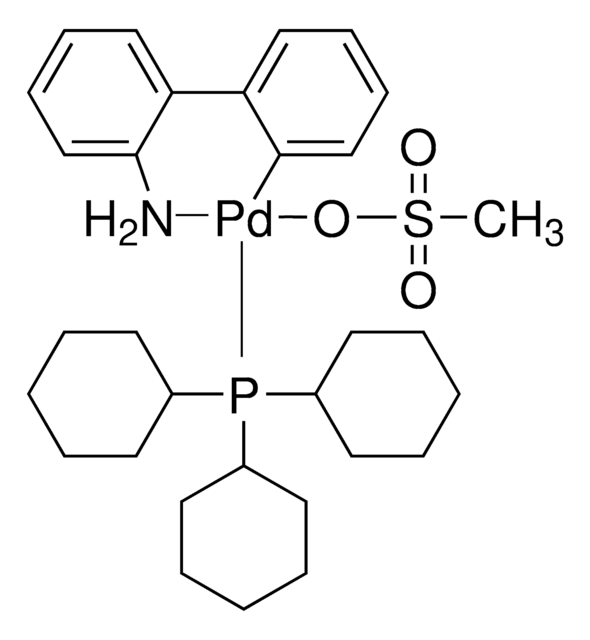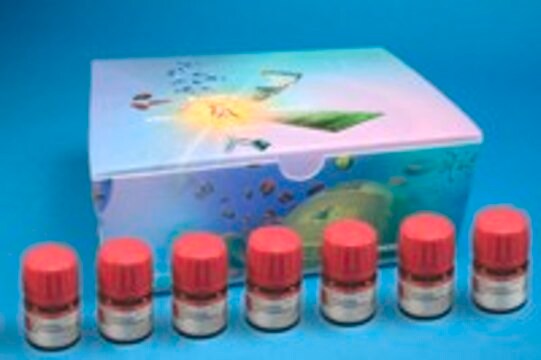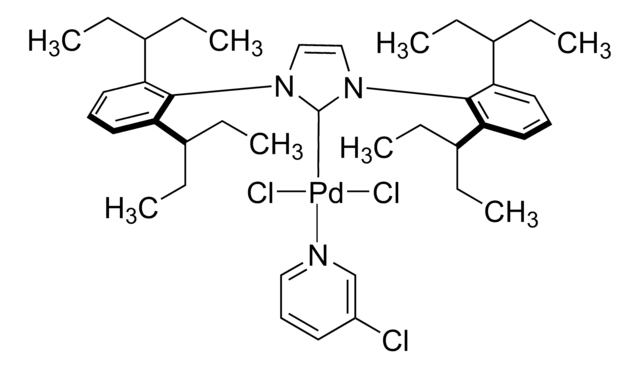KITALYSIS-SM
KitAlysis™ High-Throughput Suzuki-Miyaura Cross-Coupling Reaction Screening Kit - Pack of 4
Synonym(s):
Suzuki-Miyaura Cross-Coupling
About This Item
Recommended Products
reaction suitability
reaction type: Cross Couplings
reaction type: Suzuki-Miyaura Coupling
reagent type: catalyst
core: palladium
functional group
phosphine
Application
Step-by-Step Guide for Suzuki-Miyaura Cross-Coupling Reaction Screening Kit
Downloadable experimental excel sheet
Each kit contains 4 customizable screening sets that include the following components:
- 6 x 4 pre-weighed catalysts in glass vials loaded with stir bars and topped with cap mat.
- 1 (2 mL) ampule each of Toluene, THF, n-Butanol, DMAc, and aq. 1.5 M K3PO4.
- 4 NEW KitAlysis 24-Well Reaction Block Replacement Films.
- 4 substrate reaction vials with stir bars.
- 1 internal standard.
Best when used with KitAlysis Benchtop Inertion Box and 24-well Reaction Block (sold separately).
Features and Benefits
- Designed and tested by synthetic chemists.
- Easily run 24-microscale reactions in parallel.
- 10 μmol reactions with 1 μmol catalyst, 3 equiv. base, 0.1 M concentration.
- Customizable Excel Template for quick calculations and easy incorporation into electronic laboratory notebooks.
Legal Information
Kit Components Only
- SnapIT Ampule Opener, Regular, for 1-2ml, 5-10ml, 10-15ml ampoules 1 EA
Kit Components Also Available Separately
- 732117Pd-PEPPSI™-IPent catalyst, ≥95% 5 µmolSDS
- 753009SPhos Pd G2 5 µmolSDS
- 761311cataCXium® A Pd G2 5 µmolSDS
- 763381XPhos Pd G3, 98%, 1:1 MTBE adduct 5 µmolSDS
- 764175P(Cy3) Pd G3, 97% 5 µmolSDS
- 764183APhos Pd G3, 97% 5 µmolSDS
- 900522Toluene, anhydrous, ZerO2®, 99.8% 8 mLSDS
- 900636Tetrahydrofuran, anhydrous, inhibitor-free, ZerO2®, ≥99.9% 8 mLSDS
- 9006391-Butanol, anhydrous, ZerO2®, 99.8% 8 mLSDS
- 900634N,N-Dimethylacetamide, anhydrous, ZerO2®, 99.8% 8 mLSDS
- Degassed Potassium phosphate tribasic solution 8 mL
- Z118850Spinbar® magnetic stirring fleas, red, L 10 mm, diam. 3 mm 1 EASDS
recommended
related product
Signal Word
Danger
Precautionary Statements
Hazard Classifications
Acute Tox. 4 Dermal - Acute Tox. 4 Inhalation - Acute Tox. 4 Oral - Aquatic Acute 1 - Aquatic Chronic 1 - Asp. Tox. 1 - Carc. 2 - Eye Dam. 1 - Flam. Liq. 2 - Repr. 1B - Skin Irrit. 2 - STOT RE 2 - STOT SE 3
Target Organs
Central nervous system, Respiratory system
Supplementary Hazards
Storage Class Code
3 - Flammable liquids
Flash Point(F)
1.4 °F
Flash Point(C)
-17 °C
Regulatory Listings
Regulatory Listings are mainly provided for chemical products. Only limited information can be provided here for non-chemical products. No entry means none of the components are listed. It is the user’s obligation to ensure the safe and legal use of the product.
EU REACH Annex XVII (Restriction List)
Choose from one of the most recent versions:
Certificates of Analysis (COA)
Sorry, we don't have COAs for this product available online at this time.
If you need assistance, please contact Customer Support.
Already Own This Product?
Find documentation for the products that you have recently purchased in the Document Library.
Customers Also Viewed
Articles
All of the preformed catalysts used in the kit are air and moisture stable complexes in their commercially available form.
KitAlysis High-Throughput Screening Kits provide solution to efficiently identify or optimize suitable catalytic reaction conditions. Chemist can rapidly run 24 unique micro scale reactions in parallel with tailored conditions.
Multiple tools have been created to ensure your success with kit set up. Start with the more detailed guide to ensure you are comfortable with all of the steps before using the quick guides on the excel worksheet. Remember that while the technique is new, it is still organic chemistry and so the steps will seem easy once you try just one kit. It is just a new way of approaching something you are already very good at.
Materials Included in your KITALYSIS-24PD-2PK High-Throughput Screening Kit
Protocols
A step-by-step protocol guide for KitAlysis Suzuki-Miyaura Cross-Coupling Reaction Screening Kit.
Related Content
Chemical reaction design and optimization in organic synthesis aims to precisely alter reaction parameters to achieve optimum results in finding pathways to target molecules.
Our team of scientists has experience in all areas of research including Life Science, Material Science, Chemical Synthesis, Chromatography, Analytical and many others.
Contact Technical Service